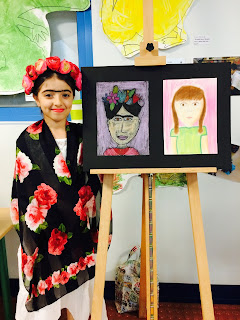This photo is one of my favorites from my whole teaching career. I learned that there is no limit on students' creativity. They are capable of so much if you let them spread their wings.
As I became more experienced in PYP I realized the need to offer more choice-based options in the art room. Choice on a large scale came to fruition during preparations for the 5th grade PYP Exhibition, which is the final display of learning for the year and is a very self-directed process for the students.
With one month to go before Fine Arts Night, students were tasked with choosing an artist, creating a work inspired by that artist's style, and then, for a little fun, presenting their artwork as if they were their chosen artist. More than an art project and dressing up, students had to research their artist, influences, and the background of the pieces they wanted to focus on. Each student struck out in their own direction and my role was to facilitate. Help them choose materials, point them in the direction of helpful resources, and most of all to have faith in their project.
Since this was my first time completely relinquishing control of a project's outcome I admit there were some jitters on my part. Some of my most promising students struggled to pick just one artist and their challenge was focus and actually completing their work on time. Others had to pick an artist that captured their interest but whose work could also be created with our materials and in our timeframe. Then there were students who just needed to work. Not occupying the peanut gallery for everyone else's project.
Ah! Deep breath. They can do it! Right??
Heck yes, they did! I was so proud of how each student embraced their artist in dress and mannerisms. How they thoughtfully answered people's questions about their work during Fine Arts Night. Not to mention the beautiful artworks that were the highlight of the show and really did their easels proud.


















